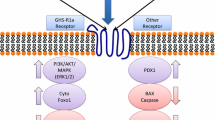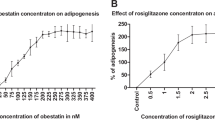Abstract
Obestatin is a recently discovered peptide encoded by the ghrelin gene that opposes ghrelin effects on food intake and gastrointestinal function. The biological activity of obestatin depends on amidation at its carboxyl terminus and on its postulated binding to the orphan G protein-coupled receptor 39 (GPR39). We have previously demonstrated that ghrelin is synthesized by cardiomyocytes and has direct effects on its viability. Our aim was to know if obestatin, derived from the same gene as ghrelin, also affects cardiomyocyte physiology. By RT-PCR and immunocytochemistry we have demonstrated that murine cardiomyocytes cultured in vitro and human atrial tissue express GPR39 receptor. Competitive binding studies with radioiodine 125I-labeled obestatin recognized specific binding sites for this peptide in the murine cardiomyocyte cell line HL-1. However, obestatin did not modify the cell cycle or viability of these cells, and it was not able to prevent the cytosine arabinoside-induced apoptosis of HL-1 cardiomyocytes, as assessed by Hoechst dye vital staining, flow cytometry analysis and determination of lactate dehydrogenase in the culture media. Finally, treatment with obestatin did not affect fatty acid or glucose uptake by HL-1 cardiomyocytes. In conclusion, obestatin is not a relevant metabolic or viability modifier for cardiomyocytes.
Similar content being viewed by others
References
Zhang JV, Ren PG, Avsian-Kretchmer O, et al. Obestatin, a peptide encoded by the ghrelin gene, opposes ghrelin’s effects on food intake. Science 2005, 310: 996–9.
Nogueiras R, Tschöp M. Biomedicine. Separation of conjoined hormones yields appetite rivals. Science 2005, 310: 985–6.
Moechars D, Depoortere I, Moreaux B, et al. Altered gastrointestinal and metabolic function in the GPR39-obestatin receptor-knockout mouse. Gastroenterology 2006, 131: 1131–41.
Bresciani E, Rapetti D, Dona F, et al. Obestatin inhibits feeding but does not modulate GH and corticosterone secretion in the rat. J Endocrinol Invest 2006, 29: RC16–8
Nogueiras R, Pfluger P, Tovar S, et al. Effects of obestatin on energy balance and growth hormone secretion in rodents. Endocrinology 2006, 148: 21–6.
Seoane LM, Al-Massadi O, Pazos Y, Pagotto U, Casanueva FF. Central obestatin administration does not modify either spontaneous or ghrelin-induced food intake in rats. J Endocrinol Invest 2006, 29: RC13–5.
Holst B, Egerod KL, Schild E, et al. GPR39 signaling is stimulated by zinc ions but not by obestatin. Endocrinology 2006, 148: 13–20.
Holst B, Holliday ND, Bach A, Elling CE, Cox HM, Schwartz TW. Common structural basis for constitutive activity of the ghrelin receptor family. J Biol Chem 2004, 279: 53806–17.
Iglesias MJ, Piñeiro R, Blanco M, et al. Growth hormone releasing peptide (ghrelin) is synthesized and secreted by cardiomyocytes. Cardiovasc Res 2004, 62: 481–8.
Claycomb WC, Lanson NA Jr, Stallworth BS, et al. HL-1 cells: a cardiac muscle cell line that contracts and retains phenotypic characteristics of the adult cardiomyocyte. Proc Natl Acad Sci USA 1998, 95: 2979–84.
Pineiro R, Iglesias MJ, Gallego R, et al. Adiponectin is synthesized and secreted by human and murine cardiomyocytes. FEBS Lett 2005, 579: 5163–9.
Munson PJ, Rodbard D. Ligand: a versatile computerized approach for characterization of ligand binding sytems. Anal Biochem 1980, 107: 220–39.
Gonzaléz-Juanatey JR, Iglesias MJ, Alcaide C, Piñeiro R, Lago F. Doxazosin induces apoptosis in cardiomyocytes cultured in vitro by a mechanism that is independent of alpha1-adrenergic blockade. Circulation 2003, 107: 127–31.
Racher AJ, Looby D, Griffiths JB. Use of lactate dehydrogenase release to assess changes in culture viability. Cytotechnology 1990, 3: 301–7.
Kojima M, Kangawa K. Ghrelin: structure and function. Physiol Rev 2005, 85: 495–522.
Sun Y, Ahmed S, Smith RG. Deletion of ghrelin impairs neither growth nor appetite. Mol Cell Biol 2003, 23: 7973–81.
Wortley KE, Anderson KD, Garcia K, et al. Genetic deletion of ghrelin does not decrease food intake but influences metabolic fuel preference. Proc Natl Acad Sci USA 2004, 101: 8227–32.
Cao JM, Ong H, Chen C. Effects of ghrelin and synthetic GH secretagogues on the cardiovascular system. Trends Endocrinol Metab 2006, 17: 13–8.
García EA, Korbonits M. Ghrelin and cardiovascular health. Curr Opin Pharmacol 2006, 6: 142–7.
Nagaya N, Kojima M, Uetmatsu M, et al. Hemodynamic and hormonal effects of human ghrelin in healthy volunteers. Am J Physiol Regulatory Integr Comp Physiol 2001, 280: R1483–7.
Nagaya N, Uematsu M, Kojima M, et al. Chronic administration of ghrelin improves left ventricular dysfunction and attenuates development of cardiac cachexia in rats with heart failure. Circulation 2001, 104: 1430–5.
Baldanzi G, Filigheddu N, Cutrupi S, et al. Ghrelin and desacyl ghrelin inhibit cell death in cardiomyocytes and endothelial cells through ERK1/2 and PI3-kinase/AKT. J Cell Biol 2002, 159: 1029–37.
Pan W, Tu H, Kastin AJ. Differential BBB interactions of three ingestive peptides:obestatin, ghrelin, and adiponectin. Peptides 2006, 27: 911–6.
Gualillo O, Lago F, Gómez-Reino JJ, Casanueva FF, Dieguez C. Ghrelin, a widespread hormone: insights into molecular and cellular regulation of its expression and mechanism of action. FEBS Lett 2003, 552: 105–9.
Sun Y, Asnicar M, Saha PK, Chan L, Smith RG. Ablation of ghrelin improves the diabetic but not obese phenotype of ob/ob mice. Cell Metab 2006, 3: 379–86.
Patel AD, Stanley SA, Murphy KG, et al. Ghrelin stimulates insulin-induced glucose uptake in adipocytes. Regul Pept 2006, 134: 17–22.
Lauwers E, Landuyt B, Arckens L, Schoofs L, Luyten W. Obestatin does not activate orphan G protein-coupled receptor GPR 39. Biochem Biophys Res Commun 2006, 351: 21–5.
Author information
Authors and Affiliations
Corresponding author
Rights and permissions
About this article
Cite this article
Iglesias, M.J., Salgado, A., Piñeiro, R. et al. Lack of effect of the ghrelin gene-derived peptide obestatin on cardiomyocyte viability and metabolism. J Endocrinol Invest 30, 470–476 (2007). https://doi.org/10.1007/BF03346330
Accepted:
Published:
Issue Date:
DOI: https://doi.org/10.1007/BF03346330




